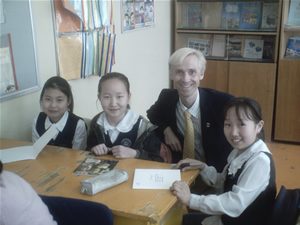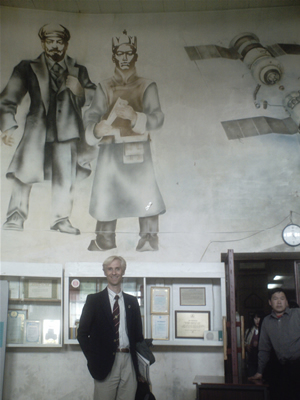|
|
Summer Travel
Journal: Mongolia
John Hickok
July 12, 2006
Greetings,
Below you will find my (very belated) May report for Mongolia.
After
leaving Mongolia, the pace of my library visits doubled, so compiling
and sending my report has been difficult. But here it is, at last!
Mongolia is truly another world. To get there from China, I traveled
via the Trans-Mongolian railroad — which feeds into the Trans-Siberian
railroad to Russia — across the vast empty lands of the country.
Mongolia is huge, but has a very small population proportionately;
50 percent of the country lives in the capital of Ulaanbaatar, and
the other 50 percent is sparsely spread about in small towns or farms.
For the past half century, Mongolia has been more closely aligned with
its northern, rather than southern, neighbor. Consequently, so much
of its look and feel is distinctly Soviet — from the Cyrillic
alphabet to the concrete “block” architecture. And, this
extends to libraries as well. Many of the librarians I interviewed
received their training in Russia, and book collections are still heavy
with Russian titles.
But since the 1990s, when the Soviet Union and its direct aid dissolved,
changes have taken place. Most libraries in recent years have switched
from the old Russian classification to Dewey Decimal Classification
(DDC). And English-language books are now filling the shelves. What
a difference a decade makes!
But there are many challenges. Funding is incredibly small at all libraries,
both public and private. Physical space is another problem — many
libraries are still using original rooms and facilities built in the
1920s-1940s. And while automation is making progress (e.g, barcode
circulation), there are many needs: not enough computers, limited Internet
access, no databases, etc.
A surprise in Mongolia is the tradition of public libraries. There
is a network of them throughout the country, even in small villages.
Of course, they may not be much more than a small reading room of some
books or newspapers, but at least the tradition is there, and literacy
is promoted. When I visited a small town library, an entire class of
school children were using it to do their reading/homework. Schools
don’t always have their own libraries, or if they do, the collection
may just be textbooks or donated books.
Though literacy may be common, Information Literacy (IL) is still far
behind. Libraries are still considered merely “repositories of
books” or study halls, rather than active places of consultation
and research. Library orientations to new students are offered, but
other than brief orientations to new students, ongoing IL instruction
is absent.
Overall, Mongolia definitely has hurdles ahead — chiefly the
limited funding/facilities — but it is moving in the right direction.
Regards from Asia,
John
Standing in front of one of the main University
of Mongolia buildings, complete with a Stalin-esque statue. And yes,
that is snow — in May! Brrr … having been in
tropical Southeast Asia for so long, I didn’t have much winter
clothing!
Visiting a Mongolian school library. The school
was an all-grade school (K-12), but mostly contained high school-level
textbooks, unfortunately. It was a delight to interact with these
students.
In the lobby of Ulaanbaatar’s public library.
The murals were quite the icons! A mix of Mongolian ethnic heritage
and Russian/Communist ideology. Ironically, right under the Lenin
mural is the “American Corner” — a room of books
and resources on America, provided by the U.S. Embassy.
Read more about John's Travels...
Japan and Korea
Taiwan
China
|





 Produced by the Office of Public Affairs at California State University, Fullerton.
Contact the
Produced by the Office of Public Affairs at California State University, Fullerton.
Contact the